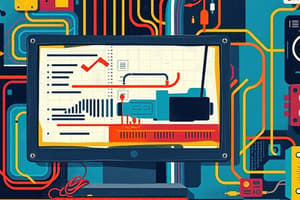Podcast
Questions and Answers
What is the minimum amount of memory recommended for optimal performance?
What is the minimum amount of memory recommended for optimal performance?
- 4 GB
- 12 GB
- 8 GB (correct)
- 16 GB
Which of the following symptoms indicates a potential need for more memory?
Which of the following symptoms indicates a potential need for more memory?
- Faster system updates
- Enhanced graphics performance
- Delayed response when selecting icons (correct)
- Increased battery life
What is the recommended amount of memory for most users?
What is the recommended amount of memory for most users?
- 12 GB
- 20 GB
- 16 GB (correct)
- 8 GB
If a user experiences frequent program freezes, what may this infer?
If a user experiences frequent program freezes, what may this infer?
Which of the following could be a consequence of having insufficient memory while multitasking?
Which of the following could be a consequence of having insufficient memory while multitasking?
What might happen when attempting to work on spreadsheets with low memory?
What might happen when attempting to work on spreadsheets with low memory?
Which memory amount is considered excellent for optimal performance?
Which memory amount is considered excellent for optimal performance?
Receiving system notifications about low memory implies which of the following?
Receiving system notifications about low memory implies which of the following?
What is likely the result of trying to open multiple applications on a computer with insufficient RAM?
What is likely the result of trying to open multiple applications on a computer with insufficient RAM?
Which of the following statements best describes a possible effect of low computer memory on overall system performance?
Which of the following statements best describes a possible effect of low computer memory on overall system performance?
Flashcards are hidden until you start studying
Study Notes
Fundamentals of ICT
- A computer is an electronic device that processes raw data into information using programs stored in memory.
- Key components of a computer include a processor (CPU), memory, and input/output devices.
Computer Hardware
- Computer hardware encompasses both internal components (motherboards, hard drives, RAM) and external devices (monitors, keyboards, mice).
- Internal components are referred to as components; external devices are called peripherals.
Input Devices
- Keyboard: Most common input device for entering data.
- Mouse: Used for selecting options; operates by moving on a surface.
- Trackball: A ball mechanism allows movement through finger or palm rotation.
- Touchpad: A touch-sensitive pad for pointer movement through finger gestures.
- Microphone: Captures audio input for commands and data.
- Headset: Combines microphone and earphone functionalities.
- Light Pen: A pointing device that resembles a pen.
- Touchscreen: Allows control via touch gestures with fingers or stylus.
- Digitizer: Converts analog signals from cameras into binary for storage.
- Magnetic Ink Card Reader (MICR): Used in banking to process cheques.
- Optical Character Reader (OCR): Reads printed text for electronic processing.
- Optical Mark Recognition (OMR): Captures data from surveys or tests.
- Smart Card Readers (SCR): Used for cards with embedded integrated circuit chips.
- Barcode Readers: Scans barcodes, converting them into alphanumeric values.
- Scanners: Convert printed materials into digital formats; includes flatbed and portable types.
Types of Embedded Systems
-
Real-time Embedded Systems:
- Respond quickly to critical situations and control external environments.
- Applications include military, medical, and industrial uses.
- Require skills in timing analysis and multitasking design.
-
Standalone Embedded Systems:
- Operate independently without additional computer connection.
- Process and display data directly.
-
Medium Scale Embedded Systems:
- Utilize 16-32 bit microprocessors or microcontrollers with external RAM/ROM.
- Requires knowledge of various programming languages and software tools.
-
Sophisticated Embedded Systems:
- Employ multiple 32-64 bit chips for large-scale tasks.
- Feature complex integration of hardware and software.
Examples of Embedded Systems
- Common examples include ATMs, digital cameras, microwaves, washing machines, and traffic lights.
Computer Memory Requirements
- Minimum memory requirement: 8 GB
- Recommended memory: 16 GB
- Optimal memory: 16 GB or more
- Symptoms of inadequate memory include poor performance, delayed responses, and multitasking difficulties.
Studying That Suits You
Use AI to generate personalized quizzes and flashcards to suit your learning preferences.




